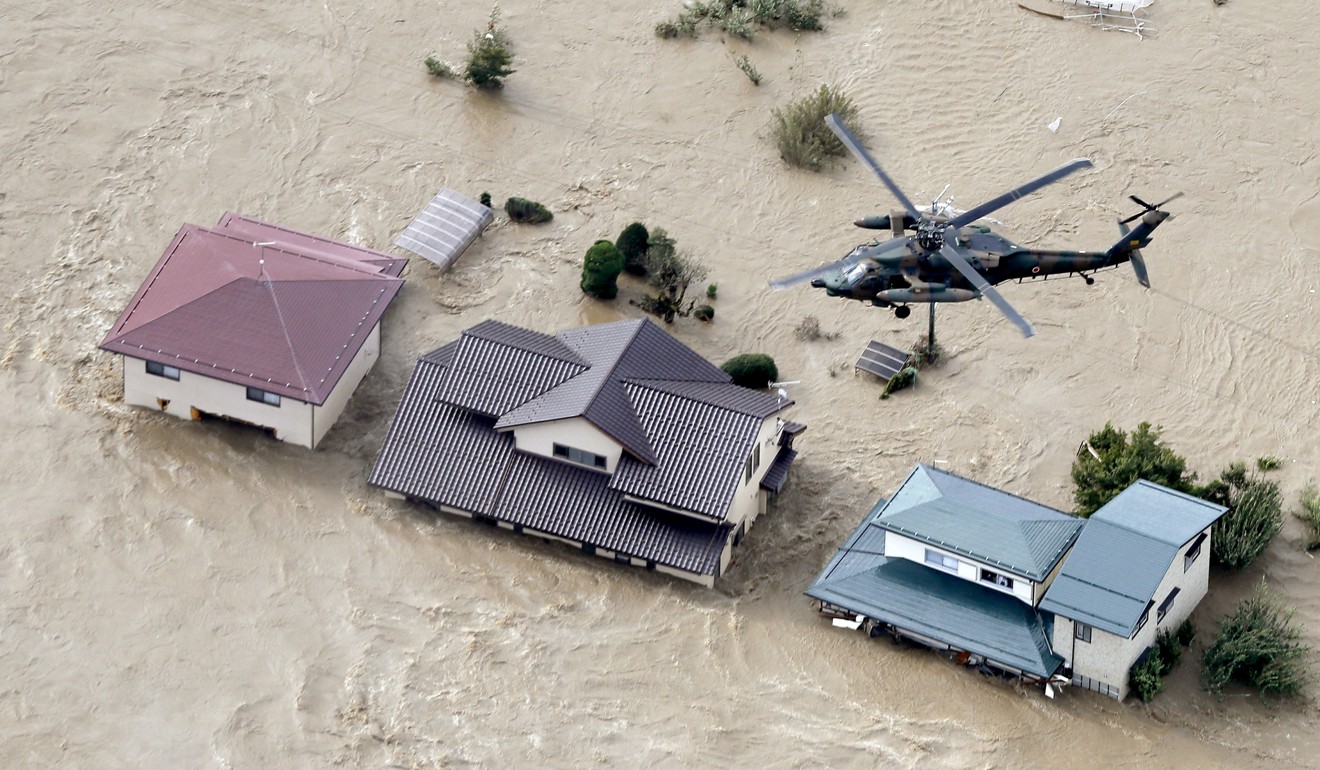
Japan braces for two more destructive storms, two weeks after chaos of Typhoon Hagibis
- Gale-force winds and heavy rain are set to lash Tokyo and the surrounding regions on Thursday evening
- Meanwhile, Typhoon Bualoi is already battering the Ogasawara Islands, south of Tokyo, with strong winds, heavy rainfall and high waves
The Japan Meteorological Agency has issued warnings for gale-force winds and heavy rain on Thursday evening in Tokyo and the surrounding regions, while Typhoon Bualoi is already battering the Ogasawara Islands, south of Tokyo, with strong winds, heavy rainfall and high waves.
About 70,000 homes were damaged or destroyed by Hagibis, which also caused the agriculture and fisheries industries in 37 of Japan’s 47 prefectures to suffer some 87.6 billion yen (US$807 million) in losses.
Typhoon Hagibis: at least 69 dead as rescuers continue search
Kazuhisa Tsuboki, a professor at Nagoya University who studies super typhoons, says Bualoi is not as powerful as Hagibis and the eye of the storm is likely to travel north over the Pacific off Japan’s east coast – but it still poses significant dangers.
“We have to be careful because it will be affected by a cyclone that is to the west. This means it will bring heavy rain to Tokyo and the eastern part of Japan, probably late on Friday and through Saturday,” he said.
The biggest concern is that yet more heavy rain will flood areas that are still feeling the effects of rivers that burst their banks under the deluge of rain from Hagibis, while hillsides that were destabilised by earlier downpours are at greater risk of collapsing.
“Studies show that sea surface temperatures around Japan have increased by around one degree in the last 100 years and projections indicate those temperatures will continue to rise until at least the end of this century,” he said.

When higher water temperatures are coupled with elevated air temperatures, the result is stronger and more powerful typhoons, with higher wind velocities and greater rainfall.
The impact of these storms is already visible in Japan. A typhoon that struck Osaka in September 2018 was the worst in 25 years and caused widespread damage in central parts of the country. That storm was eclipsed in September this year when typhoon Faxai lashed eastern Japan, destroying buildings, triggering landslides and causing widespread blackouts.
Within weeks, that disaster had been put in the shade by Hagibis, the most destructive storm to make landfall in Japan in 60 years.

Hiroo Ichikawa, a professor of urban planning at Tokyo’s Meiji University, said there are limits to what can be done to typhoon-proof Japan’s cities.
“There were big differences between the impact of the heavy rain on the Tokyo metropolitan area and outlying districts,” he said. “For a storm that big, there was not a great deal of damage in Tokyo. But it was very different for rural areas, particularly where embankments alongside major rivers broke.
“What is holding back further flood-defence measures are the limited budgets of more rural areas,” Ichikawa said.
And if rainfall on this level occurs only once every 50 years or so, it causes a dilemma as to whether spending huge amounts of limited public funds on those defences is wise, he said.
Japanese troops deployed as monster storm death toll climbs
“Perhaps a different approach is needed,” Ichikawa said. “Warnings were issued through the television, radio and mobile phones, so it may be better to use technology to develop more accurate and rapid warning systems for the public.
“If we give people more time to take action, such as evacuating a dangerous area, then we should be able to reduce the casualties,” he said.
It was also important to change the mindsets of residents, Ichikawa said.
Most the dead and missing died in their own homes after either refusing to evacuate or being unable to leave.
“We have to change the way that people think and encourage them to follow advice to evacuate,” he said. “People cannot simply blame the government; they have to take responsibility for their own well-being.”

